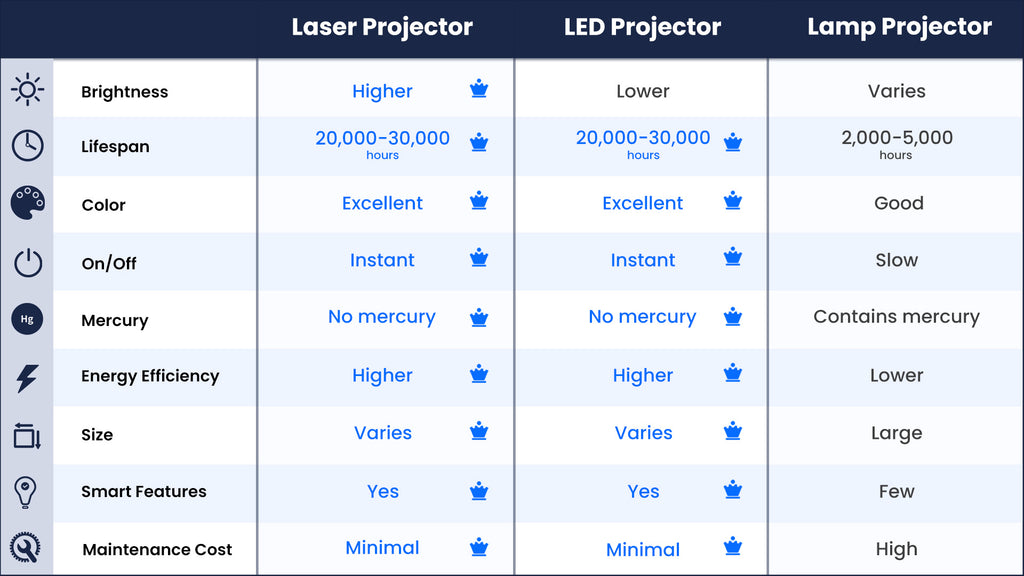No Products in the Cart

Projectors have become integral in various settings, from homes and classrooms to boardrooms and theaters. They transform static spaces into dynamic environments, delivering a visual experience that captivates audiences. In recent years, LED and laser projectors have gained substantial popularity, offering advancements in technology that redefine visual presentations. However, traditional lamp-based models still retain significance. This prompts an in-depth analysis of all three technologies.
This blog aims to provide an insightful analysis of LED, laser, and lamp projectors, shedding light on their respective technologies, performance, applications, and costs. By the end, readers will be equipped with the knowledge needed to make informed decisions based on their specific needs and preferences.

LED (light-emitting diode) projectors utilize LEDs as their light source. These diodes emit red, green, and blue light, which are then combined to create a full spectrum, resulting in vibrant and accurate images.
Laser projectors take a different approach by using lasers as the light source. Lasers can concentrate light into small, bright beams, allowing for intense levels of luminance.
Brightness and Clarity: Laser projectors are known for their exceptional brightness levels and clarity, much brighter than LED and lamp projectors. This makes them ideal for large venues and environments with high ambient light.
Lamp-based projectors have been the dominant projection technology for decades and use high-intensity electric arcs inside sealed lamps to generate light.
Key benefits of lamp projectors


Advancements in LED Technology: Ongoing research and development in LED technology promises even greater energy efficiency and color accuracy in the future. Miniaturized and portable LED models are also emerging.
Emerging Laser Projector Innovations: Lasers will become brighter and more affordable. Laser projectors in more compact form factors are also emerging, such as the Dangbei Atom.
Lamp Projectors: Lamp technology continues to advance in areas like brightness, contrast, and lamp life.
Market Predictions: The projector market is anticipated to see continued growth, with increasing demand for both LED and laser technologies. Lamp models will retain importance in their specific use cases.
Room Size: Consider the space where the projector will be used. Laser projectors excel in larger spaces. Lamp projectors are also better suited for larger spaces due to their greater volume, while LEDs are better suited for smaller rooms.
Ambient Light: The high brightness of lasers cuts through sunlight and indoor lighting better. LED and lamp projectors need controlled lighting.
Budget: Evaluate the upfront costs and total cost of ownership to align with budget constraints. Lower purchase and operating costs make LEDs the value option, while lasers provide premium performance. Lamp models are budget-friendly.
Usage Patterns: Factor in the expected usage patterns and long-term goals to make a decision that aligns with future needs. Lasers serve venues with heavy usage better. LEDs work well for lighter home and office use. Lamp models work well for occasional use.
LED, laser, and lamp projectors each have their strengths, with LED excelling in energy efficiency and color accuracy, while laser projectors boast superior brightness and longevity. Lamp projectors offer flexible brightness at accessible prices. The choice ultimately depends on individual requirements, room size, budget, and long-term goals. Carefully match your specific needs to the strengths of each technology. With smart selection, all three projectors can become indispensable presentation and entertainment tools.
Q: How do I choose from LED, laser, and lamp projectors for a home theater?
A: Consider size, lighting, and budget. Generally, LED for smaller home theaters, laser for larger dedicated home theaters, lamps for casual viewing.
Q: Are LED projectors suitable for large auditoriums and well-lit spaces?
A: LED projectors are best suited for smaller spaces and environments with controlled lighting. For larger auditoriums or well-lit areas, laser projectors with higher brightness levels may be more appropriate.
Q: Can I use LED, laser, or lamp projectors for gaming?
A: LED, laser, and lamp projectors can all be used for gaming, but considerations such as input lag, refresh rate, and resolution are essential. Some projectors are specifically designed for gaming, so it's crucial to check the specifications and reviews for optimal gaming performance.
Q: What maintenance is required for LED, laser, and lamp projectors?
A: LED projectors typically require less maintenance due to their solid-state design. Laser projectors, with sealed optical engines, also have minimal maintenance requirements. Lamp models require periodic bulb replacements.
Q: Do laser projectors consume more energy than LED projectors?
A: Generally, laser projectors consume more energy than LED projectors. However, advancements in laser technology have led to more energy-efficient models, narrowing the gap between the two technologies.
Q: Are laser projectors worth the higher cost compared to LED projectors?
A: For home theaters, large venues, and constant heavy usage, laser projectors can justify their higher price through exceptional brightness, contrast, and longevity. But for smaller home and office applications, LED provides good performance at a much lower total cost.
Q: Are there any health concerns related to prolonged exposure to LED, laser, or lamp projector light?
A: LED, laser, and lamp projectors are designed to meet safety standards, and prolonged exposure is generally considered safe. However, it's advisable to follow recommended guidelines for screen time, take breaks, and ensure proper ventilation in the viewing area.
Q: What future innovations are expected in LED and laser projection?
A: Manufacturers are enhancing LED brightness, efficiency, portability, and size. Laser innovations include higher lumens, improved color representation, shorter throw ratios, and lower pricing through simplified designs. Both technologies will also benefit from improved onboard processing and software capabilities.